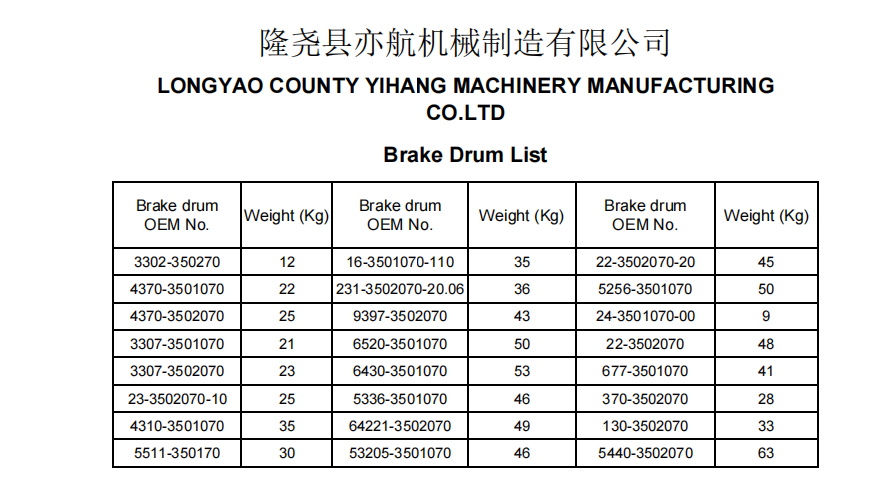Dec . 23, 2024 14:12 Back to list
Step-by-Step Guide to Replacing Your Vehicle's Brake Drums Efficiently
Understanding Brake Drum Replacement Importance, Symptoms, and Steps
Brake drums play a critical role in a vehicle's braking system. This cylindrical component is essential for the safe and effective deceleration of your vehicle. Over time, brake drums can wear down or become damaged, necessitating replacement to ensure optimal performance and safety. In this article, we will explore why brake drum replacement is essential, how to identify symptoms indicating the need for replacement, and the steps involved in the replacement process.
Importance of Brake Drum Replacement
Brake drums house the brake shoes, which press against the drum to create friction and slow down the wheels. As with any part of a car, brake drums can wear over time due to friction, heat, and environmental factors. When the drums become warped, cracked, or excessively worn, they can lead to reduced braking efficiency, which can be dangerous for the driver and passengers.
Replacing worn or damaged brake drums is crucial for maintaining safe stopping distances and overall vehicle control. Neglecting this replacement can lead to further damage to the braking system, increased repair costs, and, more seriously, it may pose a risk of brake failure while driving.
Symptoms Indicating the Need for Brake Drum Replacement
It is essential for drivers to be aware of the signs that indicate the need for brake drum replacement. Some common symptoms include
1. Unusual Noises If you hear a grinding, squeaking, or squealing noise when you apply the brakes, it could indicate that the brake shoes are worn down, and the metal is coming into contact with the brake drum.
2. Vibrations If you feel vibrations in the brake pedal or steering wheel when braking, this could signify a warped brake drum that requires immediate attention.
3. Decreased Performance A noticeable decrease in braking power or an increase in stopping distances may suggest that the brake drums are worn and not functioning correctly.
5. Visual Inspection Regular checks can reveal cracks, rust, or scoring on the surface of the brake drums. If these signs are present, it’s time to consider a replacement.
Steps for Brake Drum Replacement
brake drum replacement

Replacing brake drums can be a complex task, and it’s recommended that it be performed by a professional mechanic. However, if you are an experienced DIY enthusiast, here are the basic steps to undertake the replacement process
1. Gather Necessary Tools You will need a jack, jack stands, lug wrench, brake drum removal tool, and replacement drums.
2. Prepare the Vehicle Park the vehicle on a flat surface, engage the parking brake, and loosen the lug nuts on the rear wheels slightly while the car is still on the ground.
3. Lift the Vehicle Use a jack to lift the vehicle and secure it with jack stands. Ensure it is stable before proceeding.
4. Remove the Wheel Completely remove the lug nuts and take off the wheel to access the brake drum.
5. Remove the Brake Drum Depending on the vehicle design, you may need to remove screws or clips holding the drum in place. Once loose, slide the brake drum off the wheel hub.
6. Inspect Components Before installing new drums, inspect the brake shoes, springs, and hardware for wear or damage. Replace any components as necessary.
7. Install New Brake Drums Carefully slide the new brake drum onto the wheel hub. Ensure it fits snugly and rotate it to confirm clearance.
8. Reassemble the Wheel Reattach the wheel, hand-tighten the lug nuts, lower the vehicle back to the ground, and then fully tighten the lug nuts using a star pattern.
9. Test the Brakes Before driving, pump the brake pedal to ensure proper seating of the shoes against the new drum. Take the vehicle for a short test drive to ensure everything functions correctly.
Conclusion
Brake drum replacement is a vital aspect of vehicle maintenance that contributes to safe driving. By being proactive and understanding the signs of wear, you can ensure that your vehicle remains safe and responsive on the road. Whether you choose to take on this task yourself or seek professional assistance, prioritizing the health of your braking system is a responsibility that all drivers should take seriously.
-
Volvo Brake Drum: OEM Quality, Optimal Safety
NewsAug.27,2025
-
Durable Brake Drum MAZ for Heavy Duty Trucks | High Performance
NewsAug.26,2025
-
FUWA: Premium Quality, Reliable Performance & Innovative Solutions
NewsAug.25,2025
-
Liza Brake Drum: Superior Quality & Performance for Safe Driving
NewsAug.24,2025
-
Iveco Brake Drum | Premium OE Quality for Daily & Eurocargo
NewsAug.22,2025
-
Your Brake Drum Man: Quality & Performance Parts
NewsAug.21,2025
